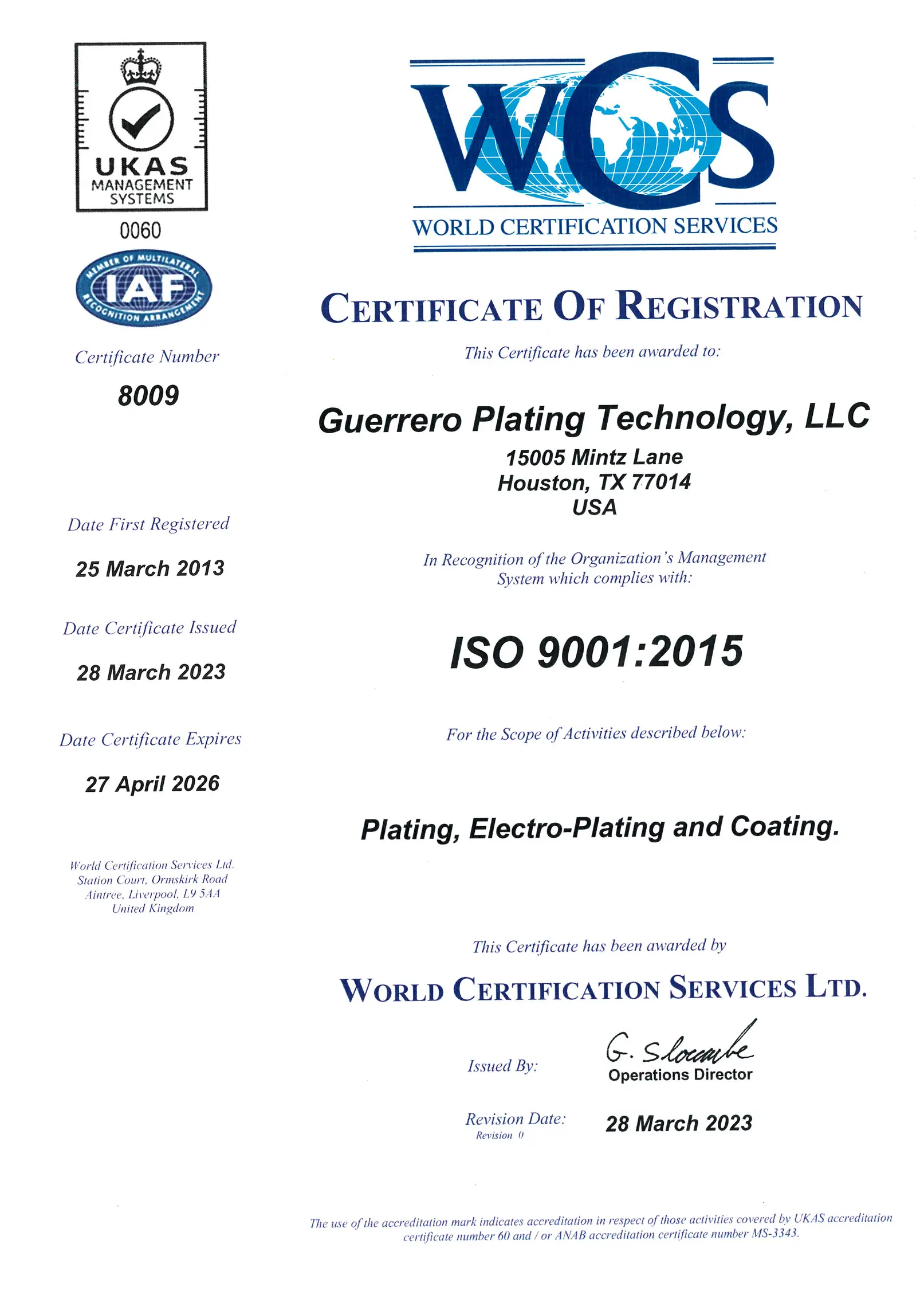Know Your Metal Plating Options
Various factors must be considered when evaluating the type of metal plating to utilize for a given application. These may include everything from initial cost and substrate compatibility to operating conditions and performance requirements. Metals like silver, copper, nickel, and palladium all have important uses, but for many industrial applications, there is no better plating material than gold.
This guide explores the key properties that make gold the ideal metal plating option for such applications and examines the costs, benefits, and challenges involved in deciding between gold plating and the alternatives.
The Gold Standard: What Makes This Noble Metal Shine?
Gold possesses several characteristics that cause it to stand out from other metal plating options and make it exceptionally useful for plating high-reliability electronic components such as contacts and connectors, including:
- Corrosion Resistance
- Gold is a noble metal perfect for corrosion-resistant plating. Air exposure will tarnish or oxidize alternatives like silver, nickel, or copper over time. Connectors plated with one of these metals will inevitably build up an oxidization layer, limiting the part’s performance.
- Gold-plated connectors, however, are not affected by these environmental conditions, as gold protects against corrosion. They remain clean and oxide-free, permanently preserving the integrity of the connection. Gold’s chemical inertness means it remains stable when exposed to acids, moisture, and other environmental contaminants.
- Excellent Conductivity
- Gold is an excellent conductive metal, enabling superior electrical flow even at low voltages and in high-temperature applications, giving it the edge as a plating option for electronic components. Gold’s low contact resistance also ensures stable electrical connections with minimal signal loss.
- Non-Magnetic Properties
- Gold is inherently a non-magnetic metal, making it ideal for sensitive electronic applications. Gold plating prevents the problem of magnetic interference that can result in signal distortion and reduced conductivity of components. High-frequency telecommunications applications like RF connectors, antennas, and microwave components also benefit from gold’s non-magnetic properties.
- Non-magnetic gold plating is essential for fields that rely on high-precision instruments, such as the aerospace and medical industries, as it prevents data corruption and ensures the continued functionality of critical devices. For components that need to operate in cleanroom conditions, gold plating prevents the accumulation of ferromagnetic particles that contaminate equipment and result in loss of functionality.
- Solderability
- Gold’s natural resistance to oxidization means that gold-plated components do not suffer from a buildup of surface oxides that can interfere with a metal’s solderability. This makes for strong bonding of solder joints and preserves the consistency of connections over time.
- Thanks to its thermal stability, gold-plated components can withstand high soldering temperatures without degradation. Gold is also compatible with various alloys used in different solder compositions. These properties make gold the best metal for plating components that rely on durable soldered connections for optimal functionality.
- Infrared Reflectivity
- Due to its infrared reflectivity, gold is essential for many aerospace applications and scientific and laboratory equipment. Gold plating has high infrared reflectivity, reducing heat absorption and protecting sensitive components from thermal damage.
- Biocompatibility
- Gold-plated components are reliable and tend to be accepted by the body, making them essential to many medical applications including implants and sensors.
- At Guerrero Plating Technology, we collaborate with clients to ensure a thorough understanding of each part’s application requirements before plating, and we certify all gold plating work to the customer’s required specifications, including ASTM and Military specs.
Gold Plating vs the Alternatives: Questions to Consider
How Cost-Effective is Gold Compared to Other Metal Plating Options?
Gold has a significantly higher material cost when compared to alternatives like silver, nickel, copper, or palladium. However, it is less expensive than some other plating materials, such as rhodium.
Although gold plating may require a greater initial expenditure, it also offers an excellent return on investment that offsets and justifies the expense, thanks to the following benefits:
- Long-Term Cost Efficiency: Gold-plated components’ reduced maintenance, replacement, and failure rates mean that they cost less in the long run than less reliable alternatives.
- Superior Performance: The high conductivity, increased corrosion resistance, and durability of gold plating, even under extreme conditions, warrant the expense.
- Reduced Material Use: Even a thin layer of gold plating provides benefits, decreasing overall material use and costs.
- Minimized Downtime Costs: The longevity of gold-plated components means fewer failures and the operational disruptions that go with them.
Is Gold Plating Always the Best Option?
While gold is often the superior choice for metal plating, there are scenarios in which one of the alternatives may be preferred. Some examples to keep in mind when weighing the plating possibilities include:
- Budget Constraints: If you’re operating on an extremely tight budget and don’t need high-performance components, it might make more sense to seek out a less expensive option.
- Low-Conductivity Applications: When conductivity needs are limited, lower-current electrical contacts plated with less expensive alternatives like silver or nickel may be sufficient.
- High-Wear Components: Palladium-nickel alloys offer outstanding durability and hardness for components that undergo intense use. While the thickness of gold plating affects its durability, it can suffer from intense wear and tear.
- Low Threat of Corrosion: When the risk of corrosion to components is minimal or not a critical factor in performance, nickel or tin plating may provide adequate protection.
Experience the Benefits of Gold Plating From Guerrero
Gold’s corrosion resistance, chemical stability, electrical conductivity, and other unique properties make this versatile noble metal stand out as a superior plating option for many applications across several industries. Gold-plated components can be found in everything from biocompatible medical implants keeping human bodies going strong, to infrared-resistant instruments performing precise operations in space.
At Guerrero Plating Technology, we combine expertise, advanced technology, and a commitment to quality to deliver gold plating solutions tailored to your needs. Contact us today to learn more about what the process involves, and discuss how your industry can benefit from the superior performance of gold-plated components.

